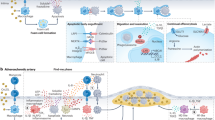Abstract
Endothelial dysfunction plays an important role in the pathogenesis of preeclampsia. Increased number of circulating endothelial cells (CECs) have previously been reported after various diseases associated endothelial injury. The aim of this study was to evaluate the CECs in patients with preeclampsia and to demonstrate any association between CECs and homocysteine, which is another marker of vascular injury. The study included 20 preeclamptic, 15 hypertensive women, 15 healthy pregnant and 15 healthy non-pregnant women. All subjects had normal renal function. Systolic and diastolic blood pressures, serum homocysteine levels were measured. To isolate CECs, peripheral blood was first incubated with anti-CD-146 antibody and subsequently conjugated to immunomagnetic beads. Cells were stained with acridine and counted. Preeclamptic patients had elevated numbers of CECs (13.2±5.2 cells/ml) compared with hypertensive patients (6.9±0.8 cells/ml), healthy pregnants (5.2±1.4 cells/ml) and non-pregnant controls (4.0±1.8 cells/ml), (P<0.0001). Serum homocysteine level in preeclamptic patients (9.5±2.8 μmol/l) was significantly higher compared with healthy pregnants (6.0±0.6 μmol/l), was not different from hypertensive patients (11.5±2.3 μmol/l, P>0.05), but it was lesser compared with non-pregnant controls (12.2±3.3 μmol/l, P<0.0001). Also, significant correlation between CECs and systolic blood pressure (P<0.0001, r=0.63), diastolic blood pressure (P<0.0001, r=0.64) and serum homocysteine (P<0.01, r=0.55) levels were found in preeclamptic patients. CECs as a marker of endothelial injury were significantly higher in patients with preeclampsia than in hypertensive patients, healthy pregnants and normal controls. Further studies are needed for the prognostic and potential importance of CECs in preeclampsia.
This is a preview of subscription content, access via your institution
Access options
Subscribe to this journal
Receive 12 digital issues and online access to articles
$119.00 per year
only $9.92 per issue
Buy this article
- Purchase on Springer Link
- Instant access to full article PDF
Prices may be subject to local taxes which are calculated during checkout


Similar content being viewed by others
References
Zhou Y, Damsky CH, Fisher SJ . Preeclampsia is associated with failure of human cytotrophoblasts to mimic a vascular adhesion phenotype. J Clin Invest 1997; 99: 2152–2164.
Sibai B, Dekker G, Kupferminc M . Preeclampsia. Lancet 2005; 365: 785–799.
Kim SY, Ryu HM, Yang JH, Kim MY, Ahn HK, Lim HJ et al. Maternal serum levels of VCAM-1, ICAM-1 and E-selectin in preeclampsia. J Korean Med Sci 2004; 19: 688–692.
Wolf M, Hubel CA, Lam C, Sampson M, Ecker JL, Ness RB et al. Preeclampsia and future cardiovascular disease: potential role of altered angiogenesis and insulin resistance. J Clin Endocrinol Metab 2004; 89: 6239–6243.
Haubitz M, Woywodt A . Circulating endothelial cells and vasculitis. Intern Med 2004; 8: 660–667.
Dignat-George F, Sampol J, Lip G, Blann AD . Circulating endothelial cells: realities and promises in vascular disorders. Pathophysiol Haemost Thromb 2003/2004; 33: 495–499.
Holmen C, Elsheikh E, Stenvinkel P, Qureshi AR, Pettersson E, Jalkanen S et al. Circulating inflammatory endothelial cells contribute to endothelial progenitor cell dysfunction in patients with vasculitis and kidney involvement. J Am Soc Nephrol 2005; 16: 3110–3120.
Woywodt A, Streiber F, de Groot K, Regelsberger H, Haller H, Haubitz M . Circulating endothelial cells as markers for ANCA-associated small-vessel vasculitis. Lancet 2003; 9353: 206–210.
Powers RW, Evans RW, Majors AK, Ojimba JI, Ness RB, Crombleholme WR et al. Plasma homocysteine concentration is increased in preeclampsia and is associated with evidence of endothelial activation. Am J Obstet Gynecol 1998; 179: 1605–1611.
Blundell G, Jones BG, Rose FA, Tudbal N . Homocysteine mediated endothelial cell toxicity and its amelioration. Atherosclerosis 1996; 122: 163–172.
Skurk C, Walsh K . Death Receptor Induced Apoptosis. A New Mechanism of Homocysteine-Mediated Endothelial Cell Cytotoxicity.. Hypertension 2004; 43: 1168.
Woywodt A, Goldberg C, Scheer J, Regelsberger H, Haller H, Haubitz M . An improved assay for enumeration of circulating endothelial cells. Ann Hematol 2004; 83: 491–494.
Hintze J . NCSS and PASS. Number Cruncher Statistical Systems. Kaysville: UT, 2001.
Koc M, Richards HB, Bihorac A, Ross EA, Schold JD, Segal MS . Circulating endothelial cells are associated with future cardiovascular events in hemodialysis patients. Kidney Int 2005; 67: 1078–1083.
Ronnback M, Lampinen K, Groop PH, Kaaja R . Pulse wave reflection in currently and previously preeclamptic women. Hypertens Pregnancy 2005; 2: 171–180.
Mignini LE, Latthe PM, Villar J, Kilby MD, Carroli G, Khan KS . Mapping the theories of preeclampsia: the role of homocysteine. Obstet Gynecol 2005; 105: 411–425.
Thadhani RI, Johnson RJ, Karumanchi SA . Hypertension during pregnancy. Hypertension 2005; 46: 1250–1251.
Gojnic M, Petkovic S, Papic M, Mostic T, Jeremic K, Vilendedic Z et al. Plasma albumin level as an indicator of severity of preeclampsia. Clin Exp Obstet Gynecol 2004; 31: 209–210.
Author information
Authors and Affiliations
Corresponding author
Rights and permissions
About this article
Cite this article
Canbakan, B., Keven, K., Tutkak, H. et al. Circulating endothelial cells in preeclampsia. J Hum Hypertens 21, 558–563 (2007). https://doi.org/10.1038/sj.jhh.1002199
Received:
Revised:
Accepted:
Published:
Issue Date:
DOI: https://doi.org/10.1038/sj.jhh.1002199
Keywords
This article is cited by
-
Endothelial dysfunction in hypertension in pregnancy: associations between circulating endothelial cells, circulating progenitor cells and plasma von Willebrand factor
Clinical Research in Cardiology (2011)
-
Relationships among adiponectin gene polymorphisms, proteinuria and increased blood pressure in the context of placental diseases
Hypertension Research (2010)



